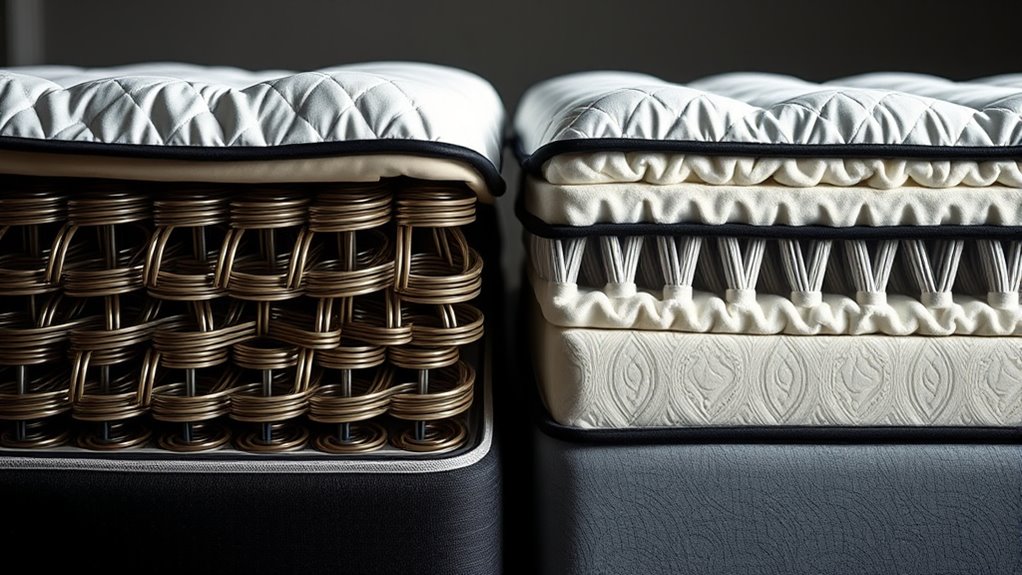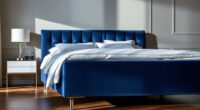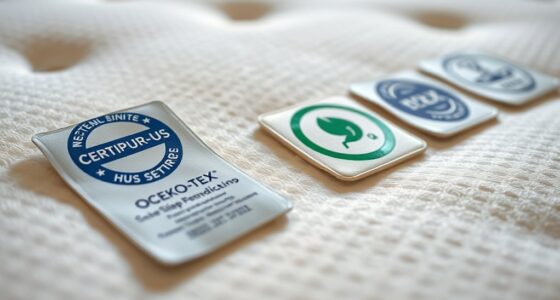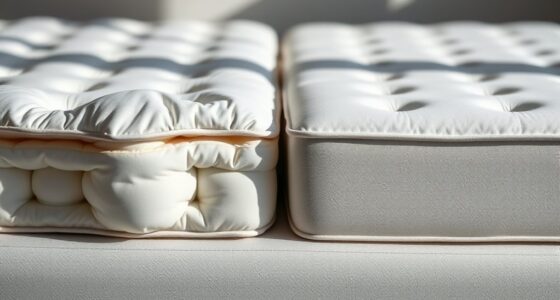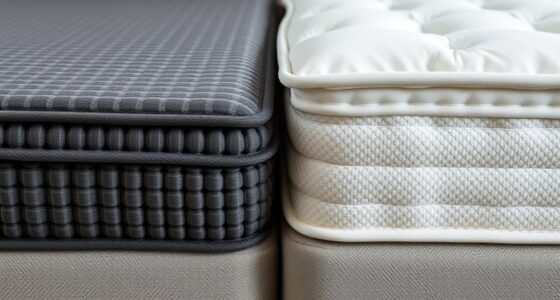Innerspring mattresses use uniform coils for support, offering a firmer feel and less contouring, while hybrids combine coils with foam or latex layers for better pressure relief and softness. Hybrids usually provide superior motion isolation and durability, but they tend to cost more. Innersprings are often budget-friendly and supportive for those who prefer a firmer mattress. To learn more about how each fits your sleep style and needs, keep exploring the details ahead.
Key Takeaways
- Innerspring mattresses feature uniform coil designs with minimal comfort layers, while hybrids combine coils with foam or latex for added contouring.
- Hybrids generally offer better pressure relief and motion isolation due to layered foam or latex atop supportive coils.
- Innersprings tend to be firmer and more supportive, suitable for those needing more support; hybrids balance support and softness.
- Hybrids typically cost more but provide enhanced durability and long-term comfort, whereas innersprings are more budget-friendly.
- Proper maintenance, like rotation and protective covers, extends the lifespan of both mattress types, with hybrids often lasting longer due to material quality.
Construction and Design Differences

While both innerspring and hybrid mattresses incorporate coils, their construction and design differ markedly. In innerspring mattresses, the coil configuration is usually uniform, with coils arranged in a grid or hourglass pattern, providing basic support. Hybrids, on the other hand, feature more advanced coil layouts, often with zoned or pocketed coils that target specific areas for enhanced support and motion isolation. Material layering also varies profoundly; innerspring models primarily consist of a thin comfort layer atop the coils, whereas hybrids combine multiple layers of foam or latex above the coil system. This layered approach in hybrids allows for better contouring and pressure relief. Additionally, self watering plant pots utilize a reservoir system that allows plants to absorb water as needed, which highlights the importance of thoughtful design in supporting plant health. Overall, the design differences influence how each mattress supports your body and responds to movement.
Comfort and Support Levels
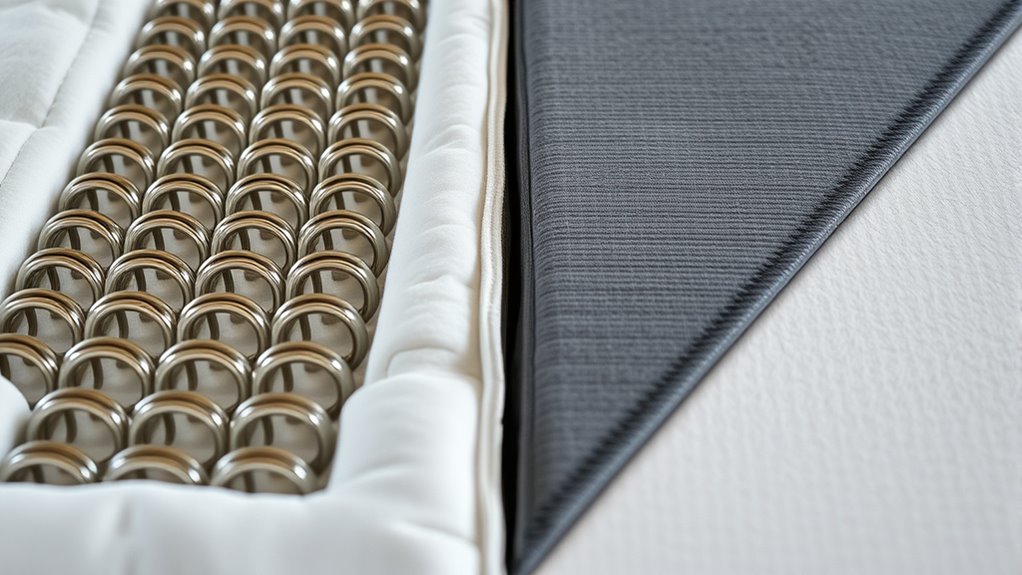
When choosing between innerspring and hybrid mattresses, comfort and support are key factors to contemplate. You’ll want to evaluate how well each mattress relieves pressure and how sturdy the edge support is. These points directly impact your sleep quality and overall mattress durability. Hybrid mattresses often combine multiple materials, such as memory foam and innerspring coils, to provide enhanced pressure relief and support.
Pressure Relief Efficiency
Pressure relief efficiency is a key factor in determining how well a mattress supports your body during sleep. In innerspring mattresses, coil responsiveness plays a significant role; responsive coils adapt quickly to your movements, providing targeted relief for pressure points. Hybrid mattresses combine coil responsiveness with material adaptability, often incorporating memory foam or latex layers that contour to your body’s shape. This synergy enhances pressure relief, reducing uncomfortable pressure buildup and promoting proper spinal alignment. If you prefer a mattress that responds instantly to your movements and offers adaptable support, hybrids often excel due to their layered design. In contrast, traditional innerspring models may offer less contouring but still provide adequate relief through their responsive coil systems. Your choice depends on your preferred balance of support and pressure distribution. Additionally, pressure relief features vary among models, so considering mattress design is essential for optimal comfort.
Edge Support Quality
Edge support is essential for maintaining comfort and stability, especially when sitting or getting in and out of bed. A mattress with good edge support provides better foundation stability, preventing sagging and ensuring the entire surface remains firm. In innerspring mattresses, edge reinforcement is often stronger due to the coil system, which helps maintain shape along the perimeter. Hybrid mattresses tend to have reinforced edges as well, but their support quality can vary depending on the design of the foam and coil integration. When edge support is lacking, you might feel unstable near the edges, which can limit your sleeping area and cause discomfort. For enhanced durability and consistent support, look for mattresses that emphasize strong edge reinforcement and foundation stability. Using quality materials can also improve overall edge support quality and extend the lifespan of the mattress.
Motion Isolation Capabilities
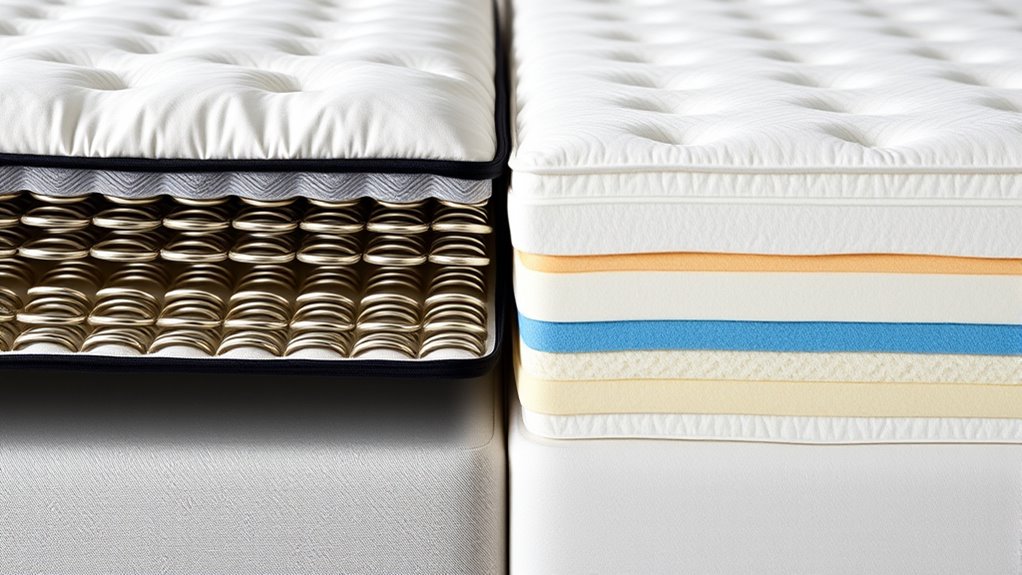
Hybrid mattresses generally offer better motion isolation than traditional innerspring models, making them a good choice if you share your bed and don’t want to be disturbed by movement. This is because hybrids often incorporate foam or latex layers that absorb motion, unlike standard innersprings that transfer movement easily. Factors like coil gauge and spring count influence how well a mattress isolates motion. Thicker coils (lower gauge) and a higher spring count can reduce transfer, but hybrids still outperform innersprings overall. Here’s a quick comparison:
| Feature | Innerspring | Hybrid |
|---|---|---|
| Coil Gauge | Higher (less dense) | Lower (more dense) |
| Spring Count | Varies, often lower | Usually higher |
| Motion Transfer | High | Low |
| Absorbing Motion | Limited | Excellent |
Additionally, the presence of foam layers in hybrids enhances their ability to absorb movement, further reducing transfer.
Durability and Longevity
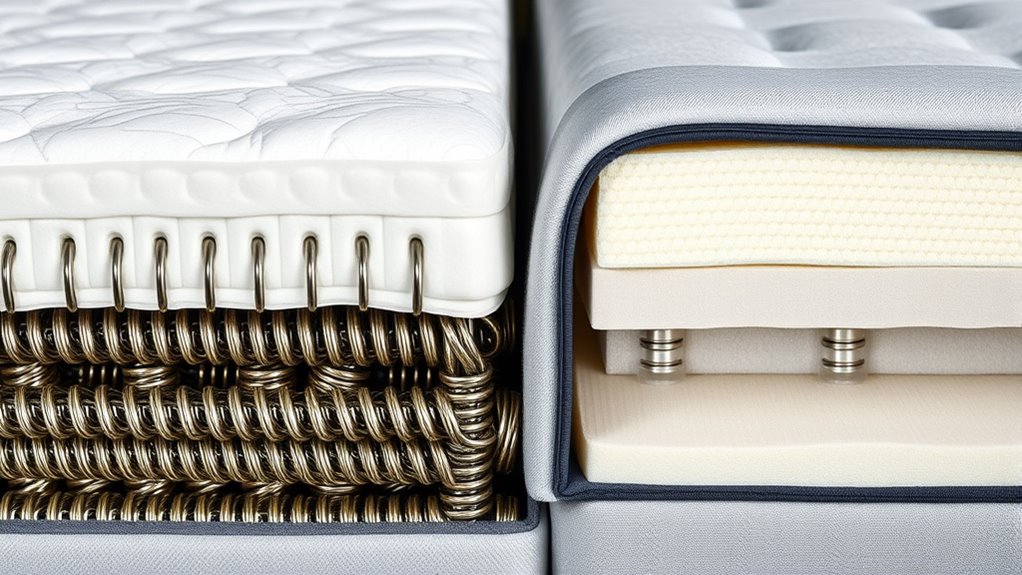
The durability of your mattress depends on the quality of materials and how well it holds up over time. You should also consider the support system’s integrity, as sagging or breakdown can shorten its lifespan. Proper maintenance and care can considerably extend how long your mattress stays comfortable and supportive. Using appropriate mattress protectors can also help preserve its condition and prolong its lifespan.
Material Quality and Wear
While both innerspring and hybrid mattresses are designed to last, their material quality and wear resistance can differ markedly. Innerspring mattresses often use steel coils combined with various padding materials, but the foam density in the comfort layers affects durability; higher foam density generally means better wear resistance. Hybrids incorporate foam layers with improved fabric breathability, which helps prevent moisture buildup and prolongs their lifespan. The quality of the fabric also influences how well the mattress resists wear, with breathable covers helping to reduce fabric degradation over time. While both types can deliver long-lasting performance, hybrids with high-quality foam and breathable fabrics tend to maintain their integrity longer, offering you better value and comfort over the years.
Support System Integrity
Support system integrity directly influences a mattress’s durability and how long it will serve you well. Proper coil placement guarantees even weight distribution and reduces sagging, extending the mattress’s lifespan. The spring gauge, which measures coil thickness, also matters; a lower gauge indicates thicker, more durable coils that resist wear. Hybrid mattresses often combine these features with foam layers for added longevity, but poor support can lead to early sagging and loss of comfort. Additionally, color accuracy in the support system can affect how well the mattress maintains its shape over time.
Maintenance and Care
Proper maintenance and care are essential to maximize the durability and lifespan of your mattress. Start by choosing the right pillow selection to support your sleeping position and prevent uneven wear. Regularly rotating your mattress—at least every three to six months—helps distribute weight evenly and prevents sagging. Keep your mattress clean by using a protective cover and vacuuming it periodically. Avoid jumping on the bed or placing heavy objects on it, as these actions can damage the coils or foam. If you notice any indentations or sagging, addressing them early can extend your mattress’s life. Additionally, understanding the importance of proper maintenance practices in prolonging your mattress’s durability is crucial. With consistent care, including proper pillow choices and routine rotation, you’ll enjoy a more supportive and longer-lasting mattress.
Price Range and Value
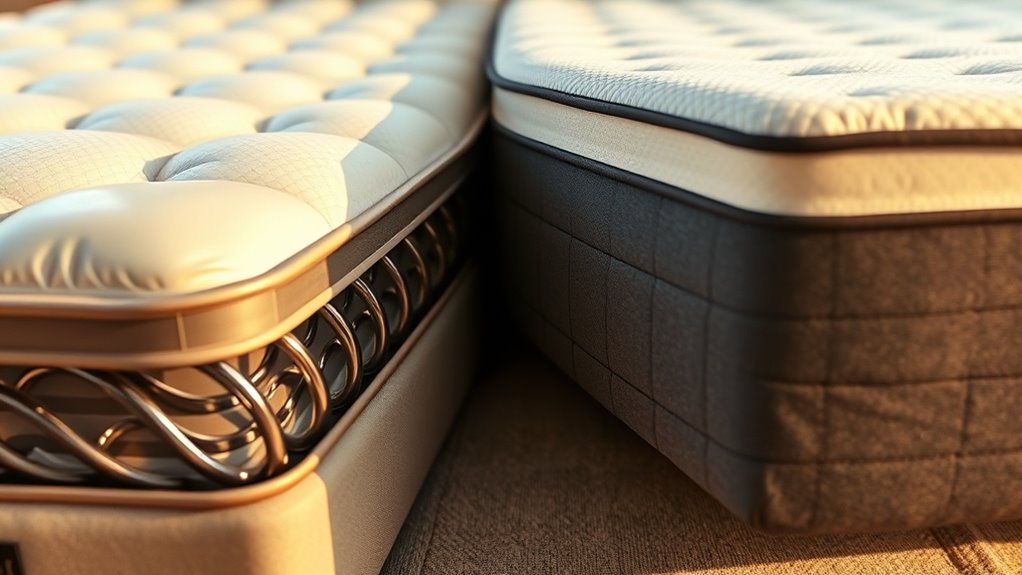
When comparing innerspring and hybrid mattresses, their price ranges reflect different levels of features and comfort. Innerspring mattresses tend to be more affordable, offering solid budget options without sacrificing basic support. They typically cost less upfront but may lack advanced features found in higher-end models. Hybrid mattresses, on the other hand, often come with premium features like memory foam layers and specialized coil systems, pushing prices higher. While hybrids can be more expensive initially, they often provide better long-term value due to enhanced comfort and durability. If you’re looking for a balance between cost and comfort, innerspring models might suit your budget better. However, investing in a hybrid could deliver more value over time through improved sleep quality and longevity. Additionally, the materials used in hybrid mattresses often contribute to their overall durability and comfort, making them a worthwhile investment for many sleepers.
Suitable Sleep Positions and Preferences
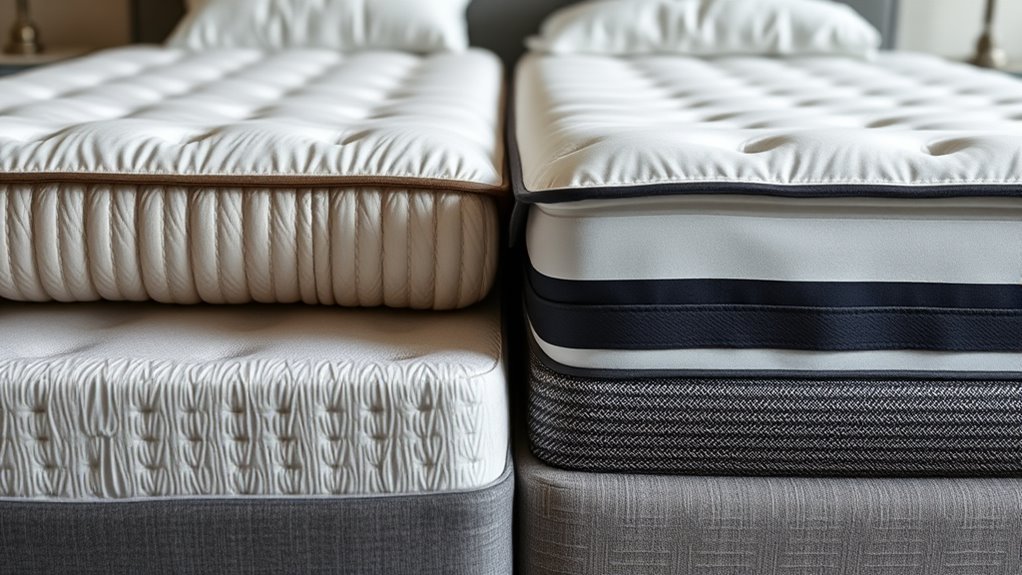
Choosing the right mattress depends heavily on your sleep position and personal preferences. If you’re a back sleeper, you’ll want a mattress that offers balanced support and spinal alignment, which both innerspring and hybrid mattresses can provide. Side sleepers often need more cushioning to relieve pressure on hips and shoulders, making softer or more contouring options ideal. Additionally, understanding the support and comfort balance offered by different mattress types can help you make a more informed decision. Consider these points:
- Back sleepers benefit from firmness that supports the natural curve of the spine
- Side sleepers prefer mattresses with good pressure relief and softer comfort layers
- Hybrid mattresses often combine support and softness, suitable for varied preferences
- Innerspring mattresses tend to be firmer, better for those who need more support
- Personal comfort and preferred sleep feel play a crucial role in your choice
Maintenance and Care Requirements
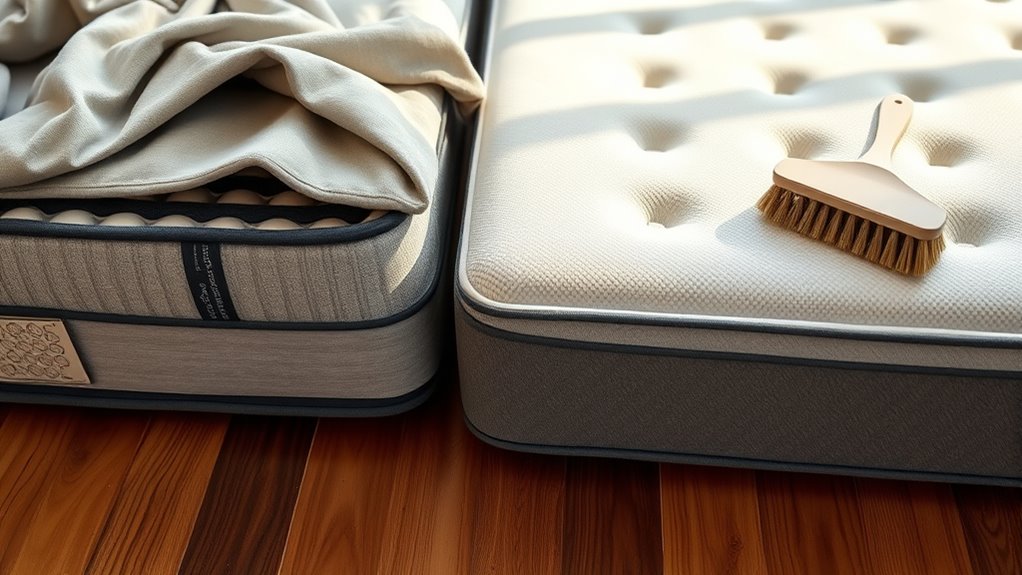
Regular maintenance and care are essential to keep your mattress in top condition and extend its lifespan. To do this, follow consistent cleaning routines and seasonal upkeep. Regularly vacuum your mattress to remove dust and allergens. Use a protective cover to prevent stains and dust buildup. Rotate your mattress every three to six months to promote even wear. Additionally, understanding latest breakthroughs in machine learning tech can help you optimize your mattress care by utilizing smart devices for monitoring sleep patterns and mattress conditions.
Frequently Asked Questions
How Do Hybrid Mattresses Compare to Foam Mattresses in Support?
When comparing support, hybrid mattresses often excel because of their coil support, which provides a sturdy, responsive foundation. Foam mattresses rely on foam resilience, offering a soft yet supportive feel, but may lack the same level of firmness and responsiveness. If you prefer a mattress that adapts to your movements while maintaining strong support, hybrids give you the best of both worlds, combining coil support with foam comfort.
Can Innerspring Mattresses Be Customized for Individual Comfort Needs?
It’s a coincidence that innerspring mattresses can be customized for your comfort needs. You can add or remove coils, choose different gauge wires, and select various comfort layers to achieve personalized comfort and mattress customization. This flexibility allows you to tailor the firmness, support, and feel to match your preferences, making innerspring mattresses a versatile option for those seeking a more individualized sleep experience.
Are Hybrid Mattresses Suitable for Allergy Sufferers?
If you’re concerned about allergies, hybrid mattresses can be a good choice because they often incorporate hypoallergenic materials that resist dust mites and allergens. Look for options with natural or synthetic covers designed for allergy sufferers, and avoid models with traditional materials that trap dust. You’ll want a hybrid mattress that combines comfort with features like dust mite resistance, so you can sleep soundly knowing it’s better suited for allergy relief.
How Do Temperature Regulation Features Differ Between the Two Types?
You’ll notice that hybrid mattresses often feature advanced cooling technology, which helps regulate temperature better than traditional innerspring options. Hybrid designs combine cooling layers and breathable materials, providing superior temperature control during sleep. In contrast, innerspring mattresses may lack these features, leading to less effective heat dissipation. So, if staying cool is a priority, a hybrid mattress with cooling technology offers a noticeable advantage for temperature regulation.
What Eco-Friendly Options Are Available for Innerspring and Hybrid Mattresses?
You might think all mattresses harm the environment, but many innerspring and hybrid options now use eco-friendly materials like organic cotton, natural latex, and recycled steel. Brands are embracing sustainable manufacturing practices, reducing chemical use and waste. These eco-conscious choices help you sleep better knowing you’re supporting sustainability. Look for certifications like GOTS or CertiPUR-US to make sure your mattress aligns with eco-friendly standards.
Conclusion
Choosing between an innerspring and a hybrid mattress ultimately comes down to your priorities. While innersprings offer affordability and traditional support, hybrids blend support with comfort, often at a higher price. The decision isn’t just about construction—it’s about how you sleep, your budget, and your desire for durability. So, weigh your needs carefully; after all, the right mattress isn’t just about the materials, but about creating a sleep environment that truly supports your lifestyle.
